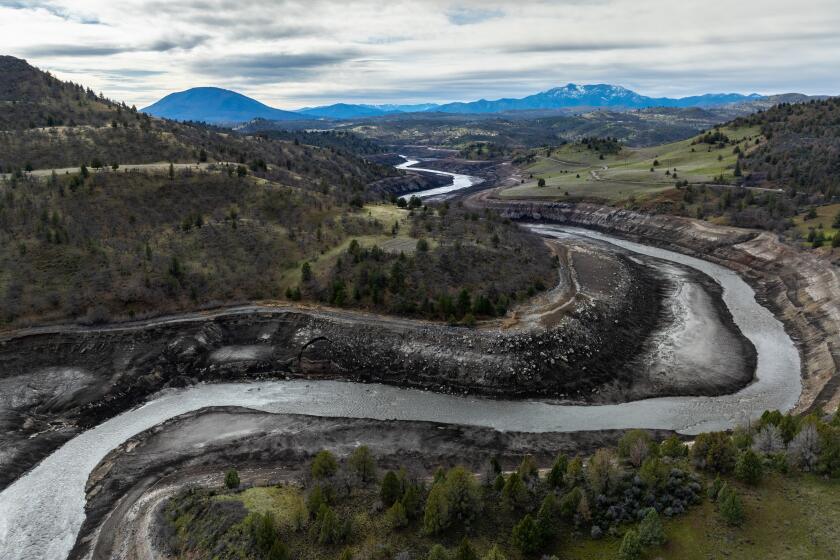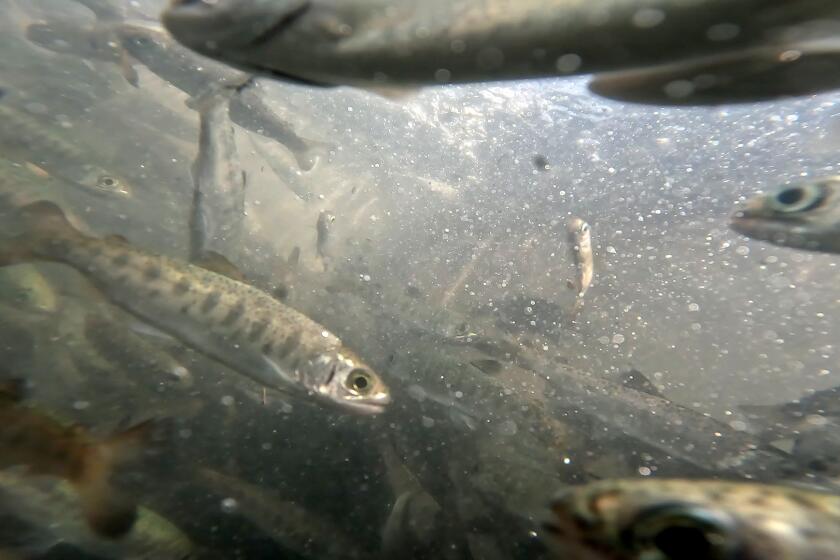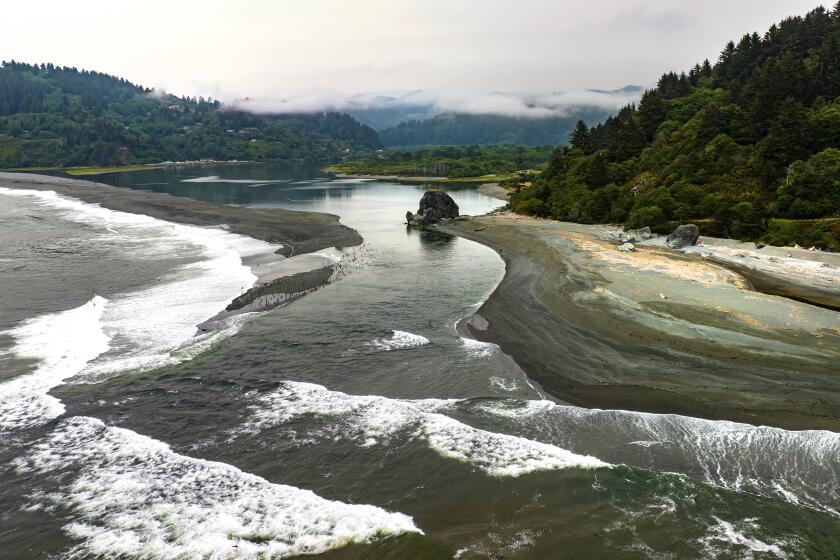As dismantling of largest dam begins on Klamath River, activists see ‘new beginning’
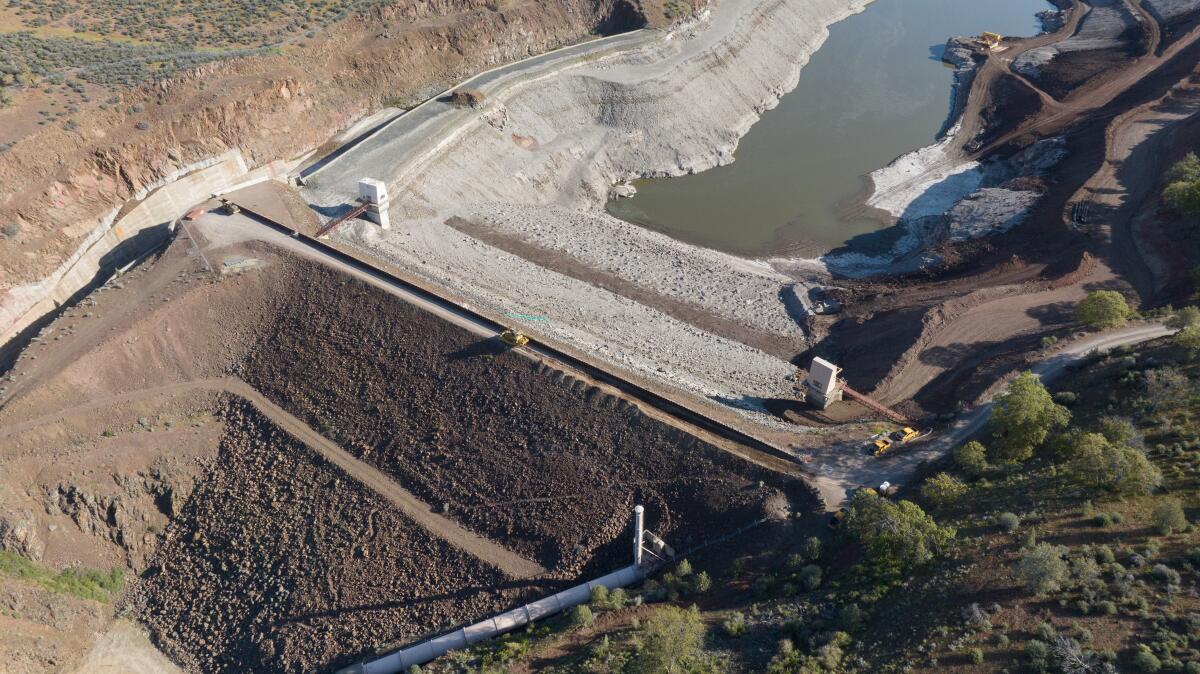
Workers have begun dismantling the largest dam on the Klamath River, using machinery to scoop the first loads of rocks from an earthen barrier that has stood near the California-Oregon border for more than six decades.
Several Indigenous leaders and activists watched as a single earthmover tore into the top of Iron Gate Dam, starting a pivotal phase in the largest dam removal project in U.S. history.
As they celebrated the long-awaited moment, they shouted, embraced and offered prayers. They said they hope to see the river’s salmon, which have suffered devastating declines, finally start to recover once Iron Gate and two other dams are fully removed later this year.
“It’s a new beginning — for not only fish, but for people as well,” said Leaf Hillman, an elder and ceremonial leader of the Karuk tribe who attended the groundbreaking Wednesday.
Aggressive and impactful reporting on climate change, the environment, health and science.
Hillman and other Indigenous activists spent more than two decades campaigning — including repeatedly protesting at utility shareholders meetings — until they finally secured agreements for the hydroelectric dams to be removed.
The smallest of the four dams was removed last year, and crews have been blasting into a second concrete dam with dynamite.
Iron Gate Dam has towered above the river since it was completed in 1962. It stands 173 feet tall and 740 feet wide.
Salmon are central to the cultures and fishing traditions of tribes along the Klamath River. But the dams have long blocked the fish from reaching areas where they once spawned, and have worsened water quality, contributing to toxic algae blooms and disease outbreaks that have killed fish.
Hillman, 60, said he and his family have witnessed the continual degradation of the river and the salmon population throughout their lives. Now, he and other tribal members are looking ahead to this fall, when they expect salmon will once again swim in a free-flowing river.
“All of us have been impacted by these dams,” he said. “And so now it represents for us a bright future.”
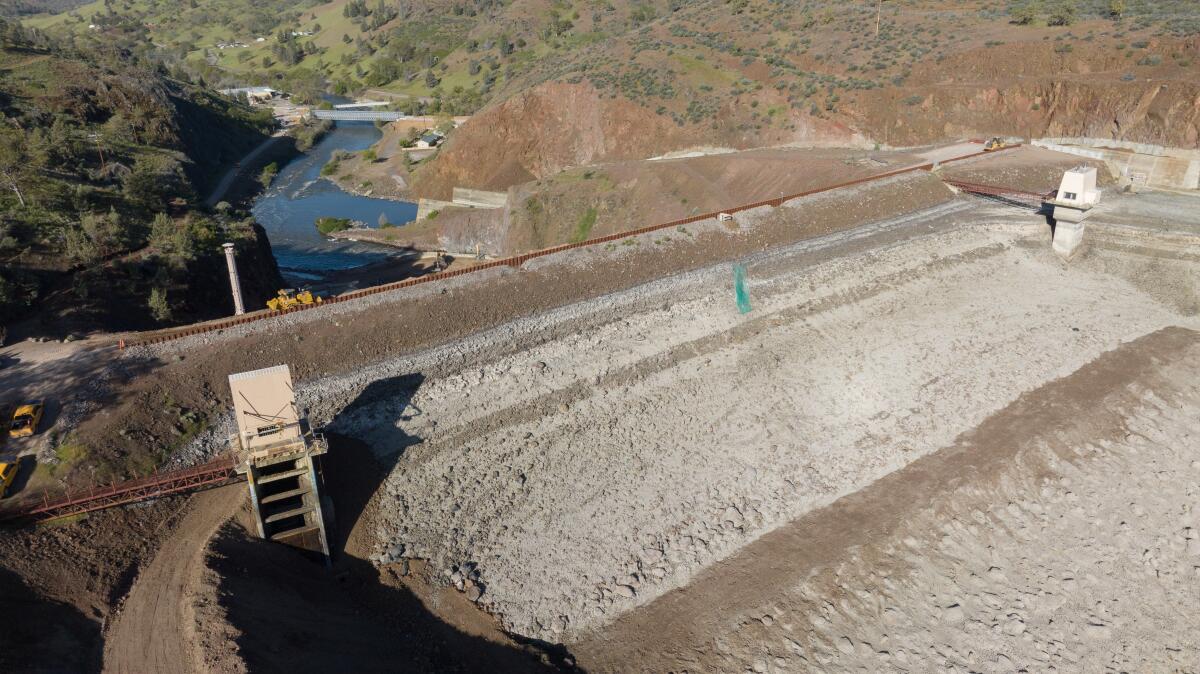
Since the reservoirs were drained in January, the river has returned to its channel, flowing through denuded lands that have been underwater for generations. Crews have been scattering seeds of native plants to help restore natural habitats along the river and its tributaries.
The project is being overseen by the nonprofit Klamath River Renewal Corp., with a $500-million budget, including funds from California and from surcharges paid by customers of PacifiCorp, a power company. The utility agreed to remove the aging dams — which were used for power generation, not water storage — after determining it would be less expensive than trying to bring them up to current environmental standards.
“After years of planning and preparation, and advocacy and activism on the part of the tribes, we’ve arrived at this major milestone to begin the removal of Iron Gate Dam,” said Mark Bransom, CEO of Klamath River Renewal Corp.
The Federal Energy Regulatory Commission granted permission for the first phase of the dam’s removal to begin, and a second authorization for the remainder of the work is expected soon.
Reservoirs have been drained as the nation’s largest dam removal effort advances on the Klamath River, and an effort to restore the watershed is taking root.
Crews hired by the contractor Kiewit Corp. will use machinery to excavate the dam’s estimated 1 million cubic yards of earthen material, including rock, sand and clay.
Some of what they remove will be used to fill in the dam’s emergency spillway, which is carved into the rock beside the river.
Most of the material will be hauled away in dump trucks, which will make thousands of trips to return the rocks and earth to the original 37-acre pit where material was quarried for dam construction.
Once the hole is filled, crews will plant vegetation to “create a more natural landscape feature,” Bransom said.
The schedule for removing the three dams calls for finishing in August or September, which will allow for Chinook salmon to migrate upstream past the sites.
“We’re on a fast track to get these dams out of the river,” Bransom said.
When the work is done, he said, “there will be very little, if any, evidence that those dams were ever there.”
California has released 500,000 salmon into the Klamath River. As dams are removed, the fish will be some of the first to return to a free-flowing river.
The dams were built without tribal consent between 1912 and the 1960s.
For Native activists who spent years demanding the removal of dams, the dismantling of Iron Gate Dam holds great symbolic significance.
Some of those who attended the gathering on a bluff overlooking the dam said they felt excited and also relieved to see the work finally starting.
Many tribal members along the Klamath began to demand change after a mass fish kill in 2002, when tens of thousands of salmon died, and filled the river with carcasses.
Brook M. Thompson, a Yurok tribe member, was 7 when she saw the river filled with dead salmon in 2002. In her high school years, she often traveled by bus to rallies and protests in Sacramento, Portland and other places.
“Really my whole life has revolved around this dam removal since seeing that fish kill,” said Thompson, now a 28-year-old doctoral student in environmental studies at UC Santa Cruz.
Seeing that excavator take that first scoop out of the dam, she said, “it feels like I can take a deep breath now.”
As they stood watching, Hillman said the group prayed. They burned a root and sent their prayers ascending with the smoke.
At one point in the celebration, someone popped open a bottle of Champagne.
Native activists fought for years to build support for taking down dams on the Klamath River in Northern California. Now, they hope removing the dams will help save their salmon.
The activists said years ago they were told they had little chance of prevailing in their fight to undam the Klamath.
“We persevered,” Thompson said. “It’s nice to know all those years I spent talking about this haven’t gone to waste.”
She said she sees the removal of dams offering hope to others who are pushing for change.
“Having this success, and being able to share that, is important for me to help relieve some of the eco-anxiety I see with youth — not only from the tribe, but from all different areas, who are fighting for a better future when it comes to climate change and these environmental issues,” Thompson said.
When the workers dumped the first load of excavated rocks, Thompson picked out a jagged reddish-orange stone about half the size of her head, and took it with her.
“I’m excited to use it as a teaching tool,” she said.
She said she planned to show the rock to students when she speaks to a high school class in San Francisco.
After the dam-removal work began, Thompson said, a group of students from the Hoopa Valley tribe brought wild grass seeds and planted them on the exposed land that had been underwater in the reservoir.
She and others say a great deal of work remains to restore the watershed’s ecosystem and ensure healthy habitat for salmon and other fish.
“We have a lot more work to do,” Hillman said. “And I think our communities are pretty well equipped with some young people that have cut their teeth on this fight.”
Hillman attended the event with his 19-year-old son, Chaas, who was in his mother’s womb when tribal members traveled to Scotland to protest at a shareholders meeting for Scottish Power, which owned PacifiCorp at the time.
Hillman said that as he watched the machinery clawing at the dam, he thought about the struggles communities have faced while the deteriorating river ecosystem has affected tribal cultures, fishing traditions and the connections among people in the Klamath River Basin. That has included negative health effects from the loss of salmon in people’s diet, he said, as well as effects on mental health and suicides among young tribal members.
Hillman said he also thought of all the people, living and dead, who helped make the undamming possible.
“There’s just been so much that’s been put into this day coming, so many people contributing to it,” Hillman said.
Taking down the dams will give the Klamath’s fish — including salmon, steelhead and lampreys — the opportunity to reconnect with their ancestral habitats. And in the same way, Hillman said, the removal of dams offers people throughout the region a chance to reconnect with the river and each other.
“It’s up to us to reestablish those connections,” he said, “and renew those bonds.”

